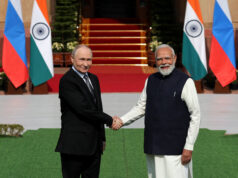‘Making America Great Again’ has been the war cry of Republican Presidential nominee Donald Trump. And during the course of the campaign, he has made some references on how he intends to do that. But Project 2025, a 922-page document drawn up by several conservative think tanks in the U.S., mentions in great detail the course Trump 2.0 could chart.
PS Raghavan, Chairman of the National Security Advisory Board, prescribes it for every student of international relations. “This document is written by people who have held top positions in the first Trump administration or with other Republican administrations. Therefore, you can be reasonably sure that this is what accords with Trump‘s thinking,” Raghavan told StratNews Global.
So what does the document entail?
Impact On India
In the last 20 years, India has done much better with Republican governments than with democratic governments in the U.S. And that’s Raghavan’s personal analysis, having worked with both the administrations.
If Trump returns, hopefully the “forked tongue approach” that we face today will go.
“There are people criticizing you on various things that you do within your country, in areas where the U.S. record, incidentally, is not necessarily much better than yours, while at the same time you have a number of areas where our cooperation is proceeding extremely well.”
That sanctimonious lecturing may stop if there’s a Republican government, he adds.
Trade
The document talks about India as a very important partner but so does the current U.S. administration. But that’s again in the context of China, which is America’s prime adversary.
The first Trump administration withdrew duty benefits on annual exports from India under the Generalized System of Preferences (GSP). One can expect all that and more as Trump talks about getting business back to the U.S., increase manufacturing and create more jobs. And while doing this, there will be uniformity. “They want to do this to their country, their friends, their adversaries, partners and allies,” says Raghavan.
But with Trump, there’s the element of negotiability. So you may be able to trade off a political gain for an economic loss, he adds. India will do well to be flexible and take advantage of that.
The China Factor
The other aspect of relations with India will be how the U.S. administration deals with China.
The underlying logic for the U.S. saying that India is important is that the hostility between India and China suits America. And while trying to keep India and China apart, the U.S. has a series of engagements with China. “The justification is that since we (the U.S.) have a wide range of interests, there are some areas where we have to complete some areas where we have to collaborate,” says Raghavan.
But Project 2025 is clear about the approach vis a vis China—total strategic decoupling.
Some of the steps proposed are
- Strategically expand tariffs on all Chinese products
- Increase tariff in such a manner and pace that will not expose the U.S. to lack of access to essential products
- Provide financial and tax incentives to American companies to onshore production from China to the U.S.
- Ban all Chinese social media apps
- Prohibit Chinese companies from bidding for U.S. government contracts
- Reduce dependence on all Chinese supply chains
- Compel the closure of Confucius Institutes
- Withdraw accreditation to any American university that might receive money from China
- Reduce or completely stop visas to Chinese researchers and students coming into the U.S.
If Chinese products are cut off from the US, they will look for an entry into the Indian market. That will pose a challenge. “Our anti-dumping policies have to be well calibrated. And at the same time, you also need to have policies that will encourage growth of industry in this country,” says Raghavan.
Nitin A. Gokhale is a media entrepreneur, one of South Asia's leading strategic affairs analyst and author of over a dozen books so far on military history, insurgencies and wars.
Starting his career in journalism in 1983, he has since led teams of journalists across media platforms.
A specialist in conflict coverage, Gokhale has covered the insurgencies in India’s North-East, the 1999 Kargil conflict and Sri Lanka’s Eelam War IV between 2006-2009.
Gokhale now travels across the globe to speak at seminars and conferences, and lecture at India’s premier defence colleges. He has founded three niche portals, Bharatshakti.in, stratnewsglobal.com and Interstellar.news.




